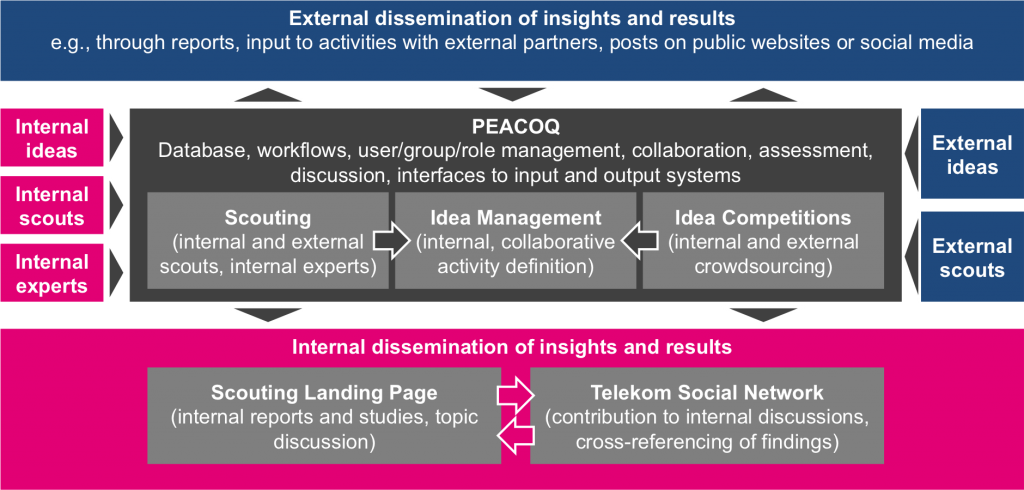 Have you also wondered how you can reduce the manual work involved in gathering and interpreting foresight insights and how you can leverage crowdsourcing mechanism and connect a large number of boundary spanners, internal technology/market experts with external scouts?
Have you also wondered how you can reduce the manual work involved in gathering and interpreting foresight insights and how you can leverage crowdsourcing mechanism and connect a large number of boundary spanners, internal technology/market experts with external scouts?
If yes, this case study on the Integrated Insight and Response System of the Deutsche Telekom Innovation Laboratories (T-Labs) can provide you with a few useful insights.
But let us first establish some of the challenges that we will face when using IT Tools for Corporate Foresight.
Challenges
- Building attention: You are addressing with corporate foresight stakeholders who are already expose (and often already oversupplied) with information from various channels and in various formats. Make sure that you communicate in the right format (action oriented) and at a right time (when decision making takes place)
- Ensuring Scalability: Once you start inviting contributors, you might quickly find yourself buried in a pile of potentially useful future insights. You need to define upfront how you want to review, categorize, assess and channel them. Typically a central team can not do this task alone and you should blend peer-review mechanisms with automated processing techniques.
- Validating your Insights: As we are dealing with inherently uncertain issues you have to boost validity of the insights through triangulations by for example combining insights from multiple sources and cross-checking database search results with expert opinions through scouting networks.
- Establish an actionable, common frame of reference: You need to avoid to introduce repeatedly new terminologies and expose your stakeholders to ever-expanding long lists of new future insights. A radar overview that matches your organizational structure often does the trick.
The approach
With about 230,000 employees and an innovation culture that encourages all employees globally to share their ideas and insights, Deutsche Telekom has a strong need to make use of IT tools to support its corporate foresight activities. The tools dedicated to its foresight activities also need to be integrated with the corporate social network as well als with internal and external prediction markets and idea competitions.
- The Scouting tool is the scalable front-end of the foresight tool, that permits to integrate insights from a large number of sources. Here in particular the insights generated via the scouting network and send by the scouts using the mobile and desktop interface provides a superb challenge for scalability. Insights that are send are however often already categorized, tagged and enhanced by attaching documents and references. They can thus be preprocessed automatically and than distributed and reviewed by a large internal group of experts, where each expert has than only a limited number of insights to process. Result: Actionable Insights
- The Innovation Idea Generation tool permits to translate future insights into innovation projects. The user can select one or multiple insights and on their basis propose a new idea. An automated text analysis matches the new ideas with existing R&D projects and other ideas in the database to avoid duplicates and permit the users to contribute with their insights to existing ideas. In addition the tool displays related ideas to further aide collaboration around ideas. All ideas can be changed—like Wiki entries—by all other users, making it easy to build on each others ideas. Result: Mature and consolidate innovation project proposals.
- Foresight Landing Page: Permits to further share the T-Labs foresight results with the entire Deutsche Telekom Group. In addition the tool hosts discussion fora and permits to also share additional information from for example start-up databases, reports and studies on future-related topics. Users throughout the global network of Deutsche Telekom are also encourage to share their own (regional) future insights which are subsequently utilized to validate the relevance of specific future insights in different regions. Result: Cross-organizational and inter-geographical strategic discussions.
An overview of architecture of the Foresight Platform of the T-Labs is provided in the figure below.
The Foresight platform has been enhanced in multiple iterations through agile engineering and eight years of trial and error. Here are the four key lessons learned.
Recommendations
- Ensure sufficient integration of internal stakeholders in the interpretation phase to lay the foundation for effective organizational responses
- Ensure easy access to the tool, ideally through a single-sign-on through the corporate Intranet and through mobile platforms
- Plan sufficient effort for coaching the users on the tool usage and for moderating the discussions within the tool
- Complement the tool with sufficient off-line workshops and trainings to trigger early buy-in and continuously high level of trust between the contributors. Make it an open and transparent system.
To learn more you can also access the full article here: Rohrbeck, R., N. Thom & H.M. Arnold (2015) IT Tools for Foresight: The Integrated Insight and Response System of Deutsche Telekom Innovation Laboratories, Technological Forecasting and Social Change, 97(8):115-126.
